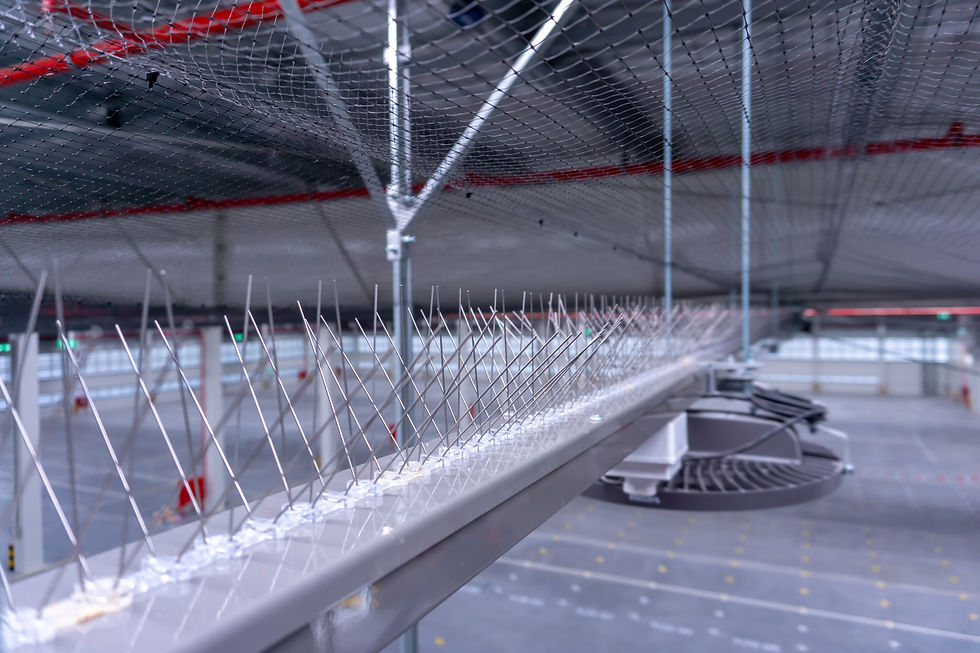Practical Strategies for Managing Pest Birds
- Compliance Pest
- Sep 10
- 3 min read
Bird infestations pose significant challenges for commercial businesses and food manufacturing facilities. Birds can cause damage to property, contaminate products, and create health hazards. Managing these pests effectively requires a clear understanding of their behaviour and the implementation of practical, compliant strategies. This article outlines key bird management strategies designed to help businesses maintain hygiene and operational standards.
Understanding Bird Management Strategies
Effective bird management starts with identifying the species involved and understanding their habits. Common pest birds include pigeons, seagulls, starlings, and sparrows. Each species has unique behaviours that influence the choice of control methods.
Inspection and Assessment
Begin with a thorough inspection of the premises. Look for nesting sites, roosting areas, and feeding sources. Pay attention to ledges, rooftops, loading bays, and waste disposal areas. Document the extent of the infestation and the times when birds are most active.
Exclusion Techniques
Exclusion is a primary strategy to prevent birds from accessing critical areas. This includes:
Netting: Install bird netting over open spaces such as loading docks and ventilation openings to physically block entry.
Spikes: Attach bird spikes to ledges, signs, and beams to deter perching.
Wiring: Use tensioned wires to create unstable landing zones on flat surfaces.
These methods are non-lethal and comply with animal welfare regulations. They are particularly suitable for food manufacturing facilities where contamination risks must be minimised.

Habitat Modification
Reducing the attractiveness of the site to birds is essential. This involves:
Waste Management: Secure bins with lids and remove food waste promptly.
Eliminating Water Sources: Fix leaks and remove standing water.
Vegetation Control: Trim trees and shrubs near buildings to reduce nesting opportunities.
By removing food, water, and shelter, businesses can discourage birds from settling.
What is the Most Effective Way to Get Rid of Birds?
Choosing the most effective method depends on the severity of the problem and the species involved. Combining several strategies often yields the best results.
Deterrents and Repellents
Visual and auditory deterrents can discourage birds from frequenting an area:
Reflective Tape and Decoys: Use shiny materials or predator decoys like owls and hawks.
Ultrasonic Devices: Emit high-frequency sounds that are unpleasant to birds but inaudible to humans.
Chemical Repellents: Apply non-toxic gels or sprays that make surfaces sticky or unappealing.
These methods work best when integrated with exclusion and habitat modification.
Professional Trapping and Removal
In cases of severe infestation, professional intervention may be necessary. Trapping and relocating birds is a controlled method that complies with wildlife protection laws. It requires expertise to ensure humane treatment and prevent re-infestation.
Regular Monitoring and Maintenance
Ongoing monitoring is critical. Inspect deterrents and exclusion devices regularly to ensure they remain effective. Promptly address any new signs of bird activity.

Implementing Compliance and Safety Measures
For food manufacturing facilities, compliance with health and safety regulations is paramount. Bird droppings can carry pathogens that contaminate food products. Therefore, bird management must align with hygiene standards such as HACCP (Hazard Analysis and Critical Control Points).
Documentation and Record-Keeping
Maintain detailed records of inspections, control measures, and maintenance activities. This documentation supports compliance audits and demonstrates proactive pest management.
Staff Training
Train staff to recognise signs of bird infestation and understand the importance of reporting issues promptly. Encourage good housekeeping practices to reduce attractants.
Choosing the Right Service Provider
Engage with pest control professionals who specialise in bird management and understand the regulatory environment. They can provide tailored solutions and ensure that interventions meet legal and safety requirements.
Advanced Bird Management Technologies
Technology plays an increasing role in bird control. Innovations include:
Automated Laser Systems: These devices project moving laser beams that birds find threatening, encouraging them to leave.
Smart Sensors: Detect bird presence and activate deterrents automatically.
Drones: Used for inspection and to scare birds from large or hard-to-reach areas.
While these technologies can be effective, they should complement traditional methods rather than replace them.

Final Thoughts on Managing Pest Birds
Managing pest birds requires a comprehensive approach that combines exclusion, deterrence, habitat modification, and compliance with health standards. Businesses must act promptly to prevent infestations from escalating. For tailored and effective pest bird solutions, partnering with experienced professionals is essential. This ensures that bird management strategies are both humane and compliant, protecting your business operations and reputation.




Comments